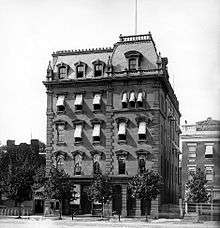Freedman's Savings Bank
The Freedman's Saving and Trust Company, popularly known as the Freedman's Savings Bank, was a private corporation chartered by the U.S. government to encourage and guide the economic development of the newly emancipated Negro communities in the post-Civil War period. Although functioning only between 1865 and 1874, the company achieved notable successes as a leading financial institution for negros. However, its failure was devastating to the newly emancipated negro communities. Its archives are valuable as a large collection of information regarding the applicants and what was known of them including some physical descriptions of complexion, where they were born and also names of family members in the immediate aftermath of emancipation. The bank maintained 37 offices in 17 states, and deposits peaked at $57 million from 70,000 depositors.

Establishment
At the end of the American Civil War, the poor economic conditions of the formerly enslaved freedmen were aggravated by the economic devastation of the Southern states. The newly freed negros had few economic resources or capital and even less exposure to private enterprise. Many soon turned to sharecropping and forced labor in the South. To help alleviate their socio-economic conditions, the Republican-controlled U. S. Congress established the Freedmen's Bureau, passing an act of incorporation and a charter for the Freedman's Saving and Trust Company, which was signed into law by President Abraham Lincoln on March 3, 1865.[1]
Originally headquartered in New York City, the first branch of the company opened in Baltimore, Maryland. By 1866, the bank had established 19 branches in 12 states, mainly in the South. The national headquarters was moved to Washington, D.C. the following year.[1]
Many former slaves were liberated by the Union Army and paid to join the army. Troops earned a little cash from their enrollment and participation, and Freedman's became the first banking entity to include them. Most accounts held between $5 and $50.[2]
Function
The bank was created specifically as a depository for black veterans, as well as former slaves and their families to build their savings. However, it also enabled numerous community organizations to increase their financial strength and expand their activities. Many societies, churches, charities, and other private organizations opened accounts and established trusts with the company.[3] With the assistance of the company, numerous hospitals, schools and institutions, such as the St. Elizabeth Home for Colored Children and the St. Francis Xavier Church's Orphan Aid Society, were established. Noted community leaders and civil rights activists served as the management of several trusts and held other important positions in the bank. Many negro soldiers and veterans of the war opened savings accounts in the banks; the management of their funds was organized through an allotment system supervised by the officers of the various army regiments.
The bank quickly built its flamboyant building headquarters in Washington DC where the Treasury Annex now stands.[2]
Failure
A series of increasingly speculative investments caused the bank to take on bad debt, while the decision to build a new building in Washington, D.C. added to its financial troubles. The bank managed to obtain the authorization from Congress to make loans backed by real estate, something that the Office of the Comptroller of the Currency (OCC) prohibits, because the bank was under the direct authority of the Congress and not the OCC.[2]
An example of the debt troubles is the Seneca Sandstone Company, the owner of the Seneca Quarry, which took out unsecured loans from the bank, approved by Henry D. Cooke, who sat on the boards of both the quarry company and the Freedman's Bank. When the Panic of 1873 struck, the quarry could not repay its debts, which helped undermine the Freedman's Bank. Both institutions went bankrupt, and the bank closed its doors in 1874. A Congressional investigation recommended that Cooke and others be indicted, but that was never followed up.[4] An 1874 court of inquiry cleared Howard of negligence, but he was transferred to the Northwest by President Ulysses S. Grant.
During the next decade, Congress established a program to reimburse depositors up to 62% of their savings, but many depositors never received any compensation. Some scholars claim that the failure of the Freedman's Bank and the loss of their savings led to a distrust of all banking institutions for several generations among the black community.[1]
Archives
The surviving documentation and papers of the bank archives illuminate the names, whereabouts and other relevant information about the veterans of the 7th Regiment United States Colored Troops and their transactions with the bank; the data is considered historically important in the study of Negro history.[3] The bank's records of 480,000 names, estimated to be the largest single repository of lineage-linked Negro records, has been indexed by The Church of Jesus Christ of Latter-day Saints. The searchable database is available to amateur as well as professional genealogists.[5] At the height of its success, the Freedman's Savings Bank held assets worth more than $3.7 million.[1]
Legacy
In 1906, Robert R. Church Sr.'s Solvent Savings Bank opened in Memphis.
See also
References
- Negro/Black History Month Freedman's Savings Bank
- "The Freedman's Savings Bank: Good Intentions Were Not Enough; A Noble Experiment Goes Awry". Office of the Comptroller of the Currency. 14 March 2019. Retrieved 5 October 2019.
- Freedman's Bank archives
- Peck, Garrett (2013). The Smithsonian Castle and the Seneca Quarry. Charleston, SC: The History Press. pp. 76–86. ISBN 978-1609499297.
- Freedman's Bank Archive on FamilySearch (may require login; create free account to search and view records)